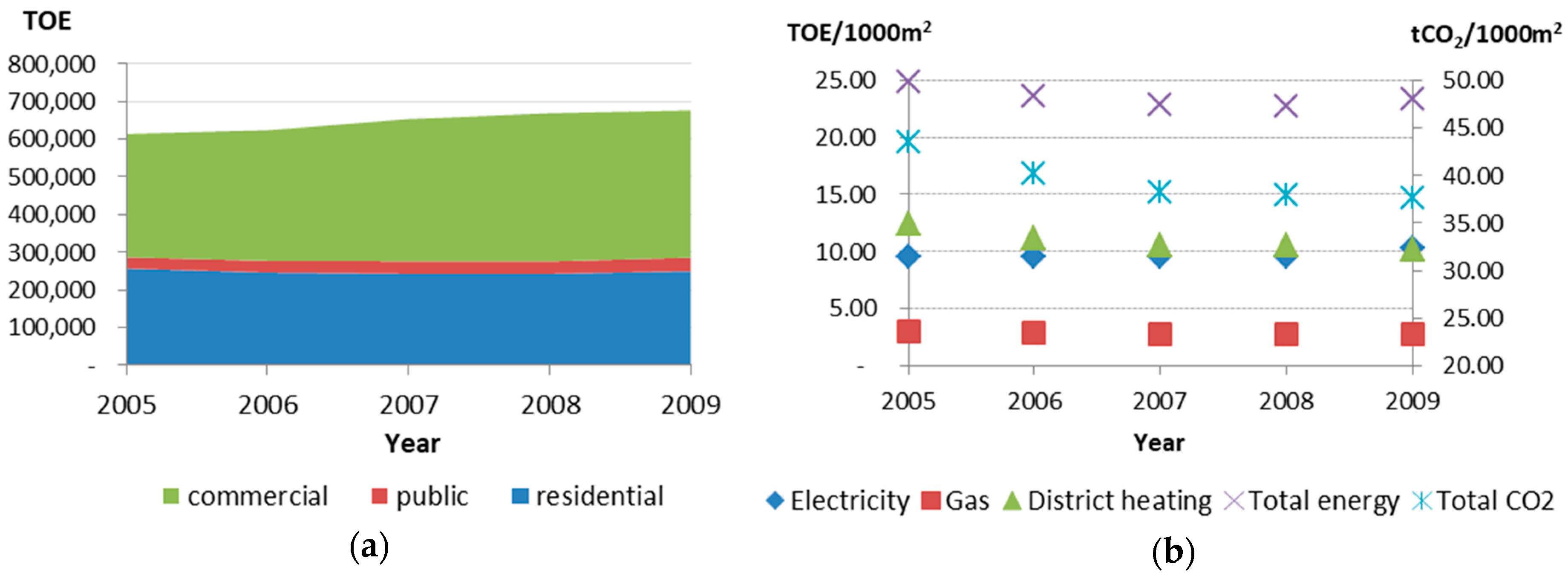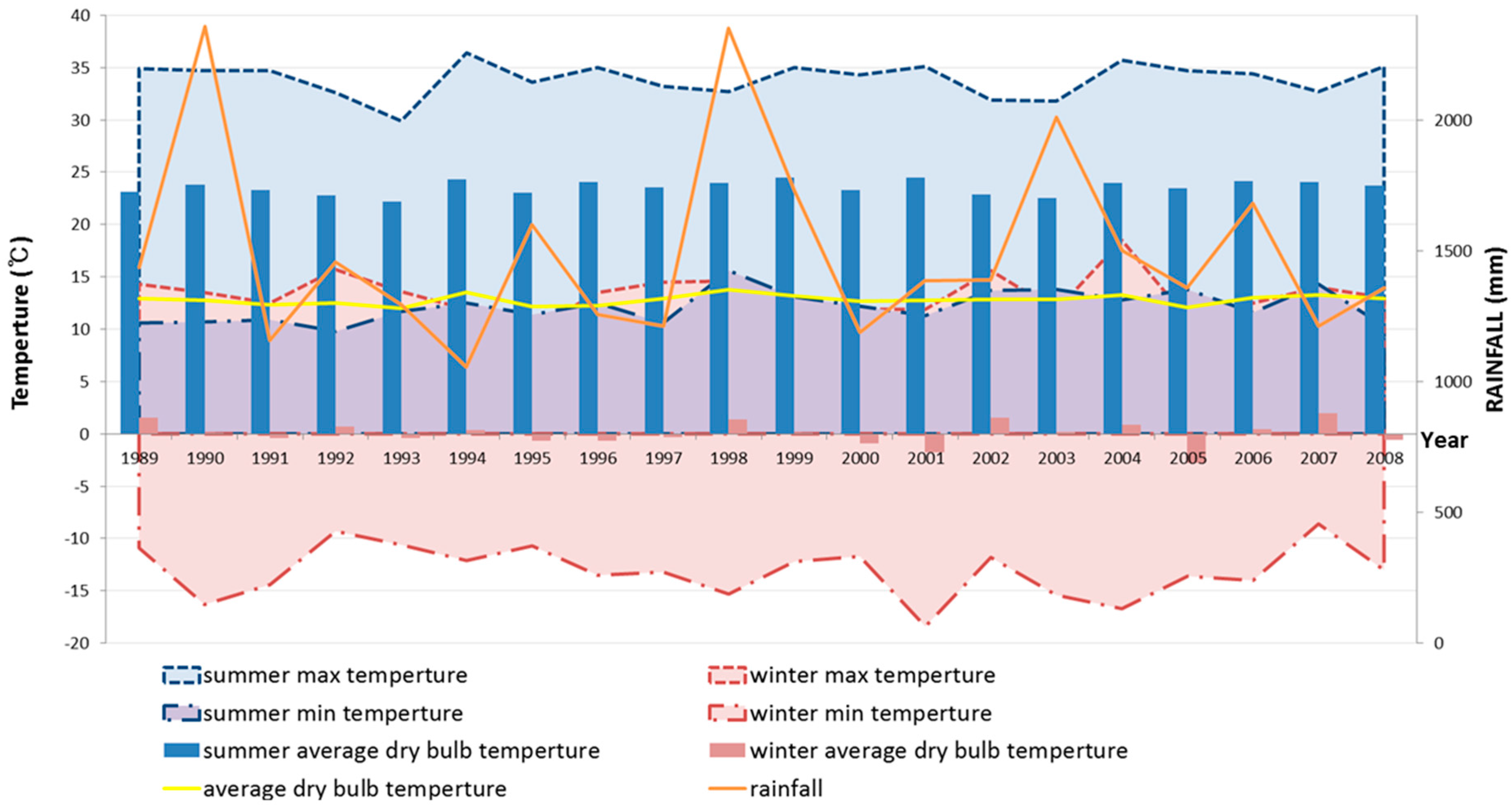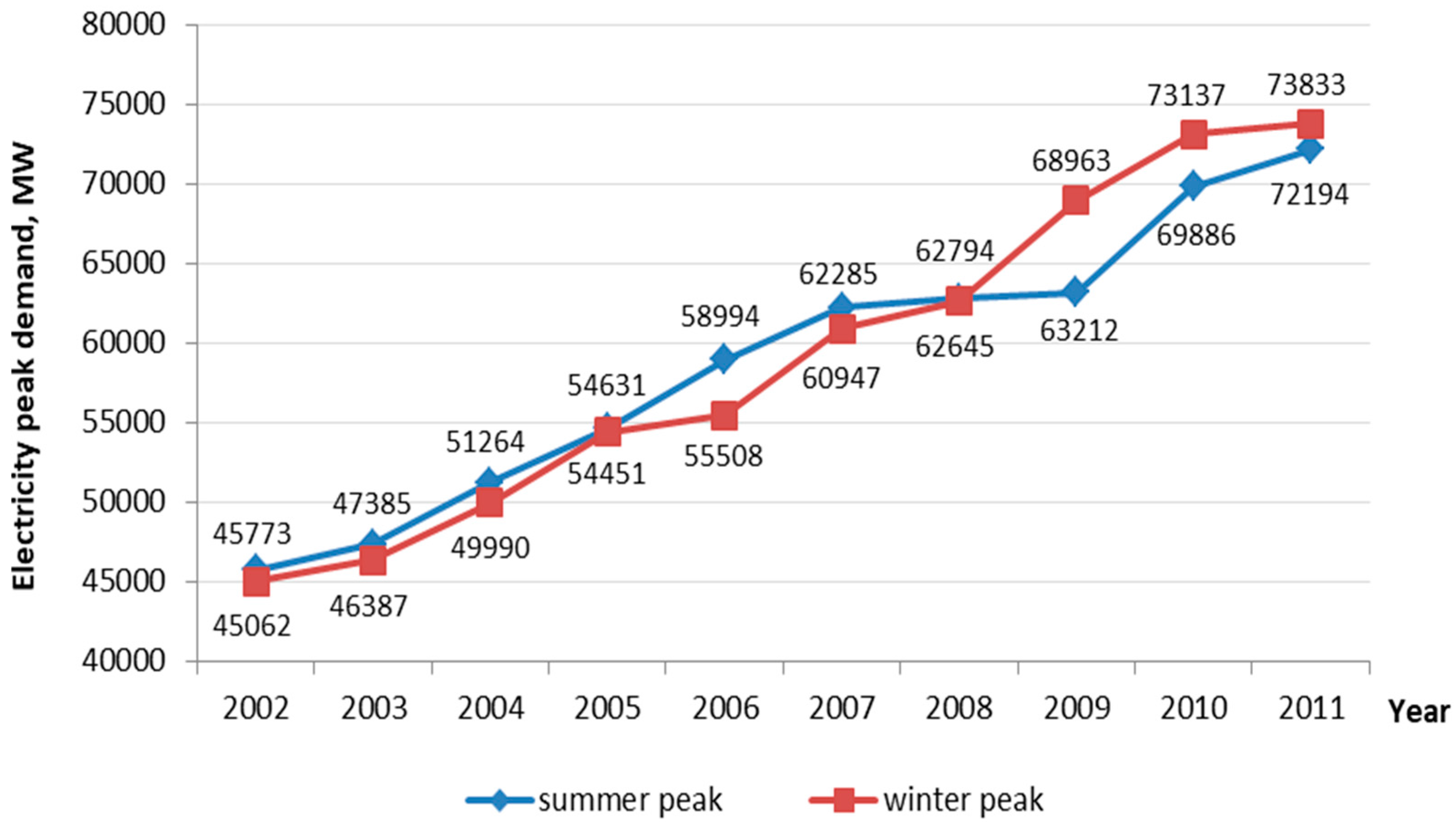Energy Demand Reduction in the Residential Building Sector: A Case Study of Korea
Abstract
:1. Introduction
2. Energy Consumption in the Residential Building Sector: The Bundang District
2.1. Energy Consumption and Sources
2.2. Energy Demands: Electricity, Gas, and District Heating
3. Domestic Energy Indicators
3.1. Household Structures and the Construction Market
3.2. Climate Changes and Building Energy Consumption
3.3. Building Laws, Policies, Acts, and Regulations
4. Discussion and Conclusions
4.1. Improving Energy Performance in Existing Residential Buildings
4.2. Strengthening Building Design Criteria for Climate Change Effects and Adaptation
4.3. Preparing a Concrete Framework to Revitalize Energy-Saving Policies
Acknowledgments
Author Contributions
Conflicts of Interest
References
- Chung, U.; Cho, J.; Yun, J.I. Urbanization effect on the observed change in mean monthly temperature between 1951–1980 and 1971–2000 in Korea. Clim. Chang. 2004, 66, 127–136. [Google Scholar] [CrossRef]
- International Energy Agency (IEA). Energy and Climate Change; World Energy Outlook Special Report; International Energy Agency: Paris, France, 2015.
- Johnston, D.; Lowe, R.; Bell, M. An exploration of the technical feasibility of achieving CO2 emission reductions in excess of 60% within the UK housing stock by the year 2050. Energy Policy 2005, 33, 1643–1659. [Google Scholar] [CrossRef]
- Minister of Land, Infrastructure and Transport (MOLIT). The 1st Green Building Master Plan; Minister of Land, Infrastructure and Transport: Sejong-si, Korea, 2014.
- Minister of Environment (ME). National Greenhouse Gas Emissions Reduction Road Map 2020; Minister of Environment: Sejong-si, Korea, 2014.
- Jeong, Y.D.; Yu, M.G.; Nam, Y. Feasibility Study of a Heating, Cooling and Domestic Hot Water System Combining a Photovoltaic-Thermal System and a Ground Source Heat Pump. Energies 2017, 10, 1243. [Google Scholar] [CrossRef]
- Oncioiu, I.; Petrescu, A.G.; Grecu, E.; Petrescu, M. Optimizing the Renewable Energy Potential: Myth or Future Trend in Romania. Energies 2017, 10, 759. [Google Scholar] [CrossRef]
- Goldsworthy, M. Towards a Residential Air-Conditioner Usage Model for Australia. Energies 2017, 10, 1256. [Google Scholar] [CrossRef]
- Coakley, D.; Raftery, P.; Keane, M. A Review of Methods to Match Building Energy Simulation Models to Measured Data. Renew. Sustain. Energy Rev. 2014, 37, 123–141. [Google Scholar] [CrossRef]
- Intrgovernmental Panel on Climate Change (IPCC). Climate Change 2014: Synthesis Report, Contribution of Working Group I, II and III to the Fifth Assessment Report; Intrgovernmental Panel on Climate Change: Geneva, Switzerland, 2015. [Google Scholar]
- Minister of Land, Infrastructure and Transport (MOLIT). Electric Architectural Administration Information System; Minister of Land, Infrastructure and Transport: Sejong-si, Korea, 2009.
- Pérez-Lombard, L.; Ortiz, J.; Pout, C. A review on building energy consumption information. Energy Build. 2008, 40, 394–398. [Google Scholar] [CrossRef]
- Wang, X.; Chen, D.; Ren, Z. Assessment of climate change impact on residential building heating and cooling energy requirement in Australia. Build. Environ. 2010, 45, 1663–1682. [Google Scholar] [CrossRef]
- Frank, T. Climate change impacts on building heating and cooling energy demand in Switzerland. Energy Build. 2005, 37, 1175–1185. [Google Scholar] [CrossRef]
- Park, K.S.; Kim, S. Building codes and energy efficiency policies with the change of the time in Korea. In Proceedings of the 13th APRU Doctoral Student Conference, Jakarta, Indonesia, 18–24 August 2014. [Google Scholar]
- Minister of land, Infrastructure and Transport (MOLIT). The 6th Basic Plan for Long-term Electricity Supply and Demand; Minister of land, Infrastructure and Transport: Sejong-si, Korea, 2013.
- Ortiz, J.; Fonseca, A.; Salom, J.; Garrido, N.; Fonseca, P.; Russo, V. Comfort and economic criteria for selecting passive measures for the energy refurbishment of residential buildings in Catalonia. Energy Build. 2016, 110, 195–210. [Google Scholar] [CrossRef]
- Ortiz, J.; Casas, A.F.; Salom, J.; Soriano, N.G.; Casas, P.F. Cost-effective analysis for selecting energy efficiency measures for refurbishment of residential buildings in Catalonia. Energy Build. 2016, 128, 442–457. [Google Scholar] [CrossRef]
- Oliveira, F.; Mendonça, P.; Couto, J.P.; Camões, A.; Silva, E. Comparative environmental and economic analysis of south european building constructive systems. WSEAS Trans. Environ. Dev. 2014, 10, 509–528. [Google Scholar]
- Garrido-Soriano, N.; Rosas-Casals, M.; Ivancic, A.; Castilloa, M.; Álvarez-del, D. Potential energy savings and economic impact of residential buildings under national and regional efficiency scenarios. A Catalan case study. Energy Build. 2012, 49, 119–125. [Google Scholar] [CrossRef] [Green Version]






| Building Type | 2010 | 2009 | 2008 | 2007 | 2006 | 2005 | 1995~2004 | 1980~1994 | Before 1979 | Total |
|---|---|---|---|---|---|---|---|---|---|---|
| Detached House | 291 | 53 | 18 | 39 | 22 | 72 | 2674 | 597 | 116 | 3882 |
| Apartment | 1984 | 16,145 | 615 | 371 | 0 | 204 | 34,135 | 59,857 | 0 | 113,311 |
| Townhouse | 137 | 189 | 0 | 0 | 18 | 62 | 4894 | 2095 | 0 | 7395 |
| Multiplex House | 11 | 7 | 62 | 32 | 23 | 138 | 707 | 0 | 0 | 980 |
| House in Non-Residential Building | 3 | 3 | 5 | 6 | 6 | 6 | 75 | 18 | 3 | 125 |
| Total | 2426 | 16,397 | 700 | 448 | 69 | 482 | 42,485 | 62,567 | 119 | 125,693 |
© 2017 by the authors. Licensee MDPI, Basel, Switzerland. This article is an open access article distributed under the terms and conditions of the Creative Commons Attribution (CC BY) license (http://creativecommons.org/licenses/by/4.0/).
Share and Cite
Park, K.S.; Kim, M.J. Energy Demand Reduction in the Residential Building Sector: A Case Study of Korea. Energies 2017, 10, 1506. https://doi.org/10.3390/en10101506
Park KS, Kim MJ. Energy Demand Reduction in the Residential Building Sector: A Case Study of Korea. Energies. 2017; 10(10):1506. https://doi.org/10.3390/en10101506
Chicago/Turabian StylePark, Kwon Sook, and Mi Jeong Kim. 2017. "Energy Demand Reduction in the Residential Building Sector: A Case Study of Korea" Energies 10, no. 10: 1506. https://doi.org/10.3390/en10101506





